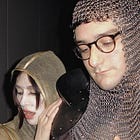Quick thank you for everyone who still subscribes (and esp to my paid subscribers) while I was away the past few weeks — I was feeling a bit burnt out but am back now <3
Trends are still relevant (sometimes)
Trends are dead this year — or so I’ve been hearing. And yet, fashion remains steadfast in its unending need for references. Sometimes, these references are seen as inventive (like Marc Jacob’s dollhouse-inspired FW25 show) and sometimes described as reductive (like Veronica Leoni’s Calvin Klein debut — depending on who you get your commentary from).
Even as we debate the death of trends (I go back and forth on this one), cultural references, events, and collective sentiment still shape what feels relevant in fashion at any given moment. In this way, fashion not only reflects the present but can also serve as evidence of — and sometimes even predict — larger cultural shifts (think of the trad wife aesthetic aligning with the rise of Trump-era conservatism).
Yes, some trends feel completely random. But sometimes (!) they tap into something bigger.
A brief timeline on the medieval trend
Medieval themes in culture/fashion/design first started gaining traction early last year in graphic design, as interest in medieval-style typefaces surged — something we can track through search volume.
Soon after, early adopters like Mina Le, Julia Fox and Caroline Polachek, all incorporated medieval themes into their outfits last spring.
As momentum built, media coverage followed, with publications like The Cut and Burn After Reading (and me, lol) covered the trend.
Search interest climbed alongside these moments, reaching a new peak when Chappell Roan wore full medieval fit while (justifiably) yelling at a reporter.
By the time Pinterest included “Castlecore” in its Pinterest Predicts report for 2025, the trend had already solidified itself.
Why it’s relevant (apart from our endless need for references)
At its core, the medieval trend ties into two major cultural interests right now: escapism and craftsmanship.
Surrealism and escapism seem to be mentioned somewhere in almost every creative trend forecast for 2024-2025 (adobe, wgsn, lsn, Wunderman-Thompson did a whole trend report on the Age of Re-Enchantment last year). A newfound interest in otherworldly fantasy is often attributed to the widespread stress, fatigue, and anxiety stemming from the various looming threats that are constantly bombarding us on social media. Escapism, whether through media consumption, fashion, or literature, offers a retreat from these pressures, according to these reports.
However, we can see the trend manifest quite literally in the growth of the fantasy fiction genre, especially among women. If we look at the data we can see strong year-on-year growth in interest across Google and TikTok, with a growing portion of that demographic being women. In the first half of 2024 alone, the adult fantasy genre witnessed a substantial increase of 85.2% compared to the first half of 2023, which a large proportion of these sales being attributed to female-focused YA authors like Sarah J. Maas and Rebecca Yarros (citation 1 and citation 2 — would love to access the raw sales data to analyse it myself, but wasn’t able to find any).
At the same time, there’s a growing search for authenticity and craftsmanship. I have made a few videos about this on instagram/tiktok but people are really starting to care about the fabrics in their clothes — with a growing number of people looking for specific fabrics when searching for basic items. Right now, fabric choice and saying “I don’t wear polyester” feels like the ultimate signifier of whether someone is “actually” into fashion or not (unless it is pleats please).
Essentially, with a surface-level rejection of fast fashion, cheap fabrics, and mass production (or at least anything that looks like it) within the fashion community, we are also seeing a trend of people searching for increasingly unique, unreplicable pieces. In an era of mass production, pieces that showcase intricate handiwork — like chainmail, embroidery, and handwoven textiles — hold more value. These aren’t things that can be easily mass-produced, and exclusivity makes them desirable — especially in an era where being unique is increasingly difficult due to the algorithmization of fashion.
How I am incorporating it
Here are my references!!
Princessy pieces like basque waistlines, square neckline layering like in mcqueen ss 17, gaudy religious references, betsy johnson fw 97, anna sui fw 28, bonnets, elaborate headpieces (mine won’t be as elaborate, but I am on the lookout), sheer layering.
Witchy velvets, more headpieces, cloaks, really close to the whimsigoth aesthetic in the 90s (probably the least historically accurate).
Knight-like chainmail, chrome, dior fw 97 couture (by john).
Maybe a harlequin pattern (currently growing in online interest — up 16% in just the past month), some whimsical layering.
Only thrifted tho (ofc).
probably not historically accurate — but thanks for reading! more trend deep dives (as well as an in-depth research paper/thing on the denim trend cycle) coming next week <3













FantasyKnightCore (Frazetta)
Yesss I’m designing a bunch of chainmail crochet pieces!